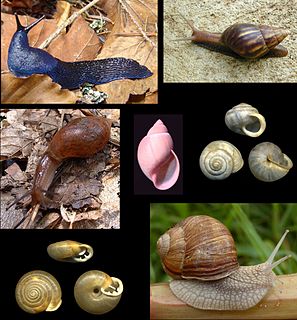
The hooked squid, family Onychoteuthidae, currently comprise about 20–25 species, in six or seven genera. They range in mature mantle length from 7 cm to a suggested length of 2 m for the largest member, Onykia robusta. The family is characterised by the presence of hooks only on the tentacular clubs, a simple, straight, funnel–mantle locking apparatus, and a 'step' inside the jaw angle of the lower beak. With the exception of the Arctic Ocean, the family is found worldwide.

Promachoteuthis is a genus of small, weakly muscled squid found at bathypelagic depths. Three species have been formally described, while another two await description.
Parateuthis tunicata, the only known member of the genus Parateuthis, is the scientific name currently given to a species of squid based on a single specimen. The validity of Parateuthis and of P. tunicata is uncertain. The sole specimen was found in the Antarctic Ocean, and is held in the repository at the Museum für Naturkunde in Berlin, Germany.

Neogastropoda is a clade of sea snails, both freshwater and marine gastropod mollusks.

Sorbeoconcha is a taxonomic clade of snails, i.e. gastropods, mainly marine species with gills and opercula, within the clade Caenogastropoda.

Philinoidea is a taxonomic superfamily of sea slugs, specifically headshield slugs, marine gastropod mollusks in the clade Cephalaspidea.

Charopidae is a taxonomic family of small air-breathing land snails, terrestrial pulmonate gastropod mollusks in the superfamily Punctoidea.
Filippovia knipovitchi, the smooth hooked squid, is a species of squid in the family Onychoteuthidae and the sole member of the genus Filippovia. It is found in the Antarctic and Atlantic Oceans, and reaches a mantle length of 35 cm.

Onykia robsoni, the rugose hooked squid, is a species of squid in the family Onychoteuthidae. It occurs in the Antarctic Ocean, at an estimated depth of 250–550 meters. The mantle of this species grows to a length of 75 cm. The species has been suggested as a junior synonym of Onykia carriboea, the tropical clubhook squid, due to similarities between the species.

Onykia is a genus of squids in the family Onychoteuthidae. Due to similarities between the genera, several recent authors consider the genus Moroteuthis a junior synonym of Onykia. The type species is Onykia carriboea, the tropical clubhook squid.

Sigmurethra is a taxonomic category of air-breathing land snails and slugs, terrestrial pulmonate gastropod molluscs. This is an informal group which includes the majority of land snails and slugs.

The Cerithioidea is a superfamily of marine, brackish water and freshwater gastropod containing more than 200 genera. The Cerithoidea are included in the clade Sorbeoconcha. The original name of this superfamily was Cerithiacea, in keeping with common superfamily endings at the time.

The Euctenidiacea, common name dorid nudibranchs, are a taxonomic suborder of sea snails or slugs, marine gastropod molluscs in the order Nudibranchia. Bouchet & Rocroi (2005) rejected the name Anthobranchia on the grounds that it also included Onchidium at the time of original publication. Doridina is equivalent and used in the latest classification.
Lanascalidae is an extinct family of sea snails, marine gastropod molluscs.

Onchidella binneyi is a species of air-breathing sea slug, a shell-less marine pulmonate gastropod mollusk in the family Onchidiidae.

Conasprella is a genus of sea snails, marine gastropod mollusks in the family Conidae, the cone snails and their allies. This genus was formerly treated by some experts as a member of the family Conilithidae and as an "alternative representation" of this group of species.
Hemistomia shostakovichi is a species of minute freshwater snail with an operculum, an aquatic gastropod mollusc or micromollusc in the family Tateidae. This species is endemic to New Caledonia, where it is only known from one small seepage behind a micro-dam in a dry valley near Voh.
Occidenthella is a genus of sea slugs, specifically aeolid nudibranchs, in the family Flabellinidae. The only described species is Occidenthella athadona, a combination named in 2017. It was originally described as Coryphella athadona in 1875. The genus name Occidenthella, from occidens, meaning "west" in Latin, refers to its distribution in the Western Pacific Ocean.
Trochida is an order of small to very large vetigastropod, Recent and extinct sea snails with gills and an operculum.













